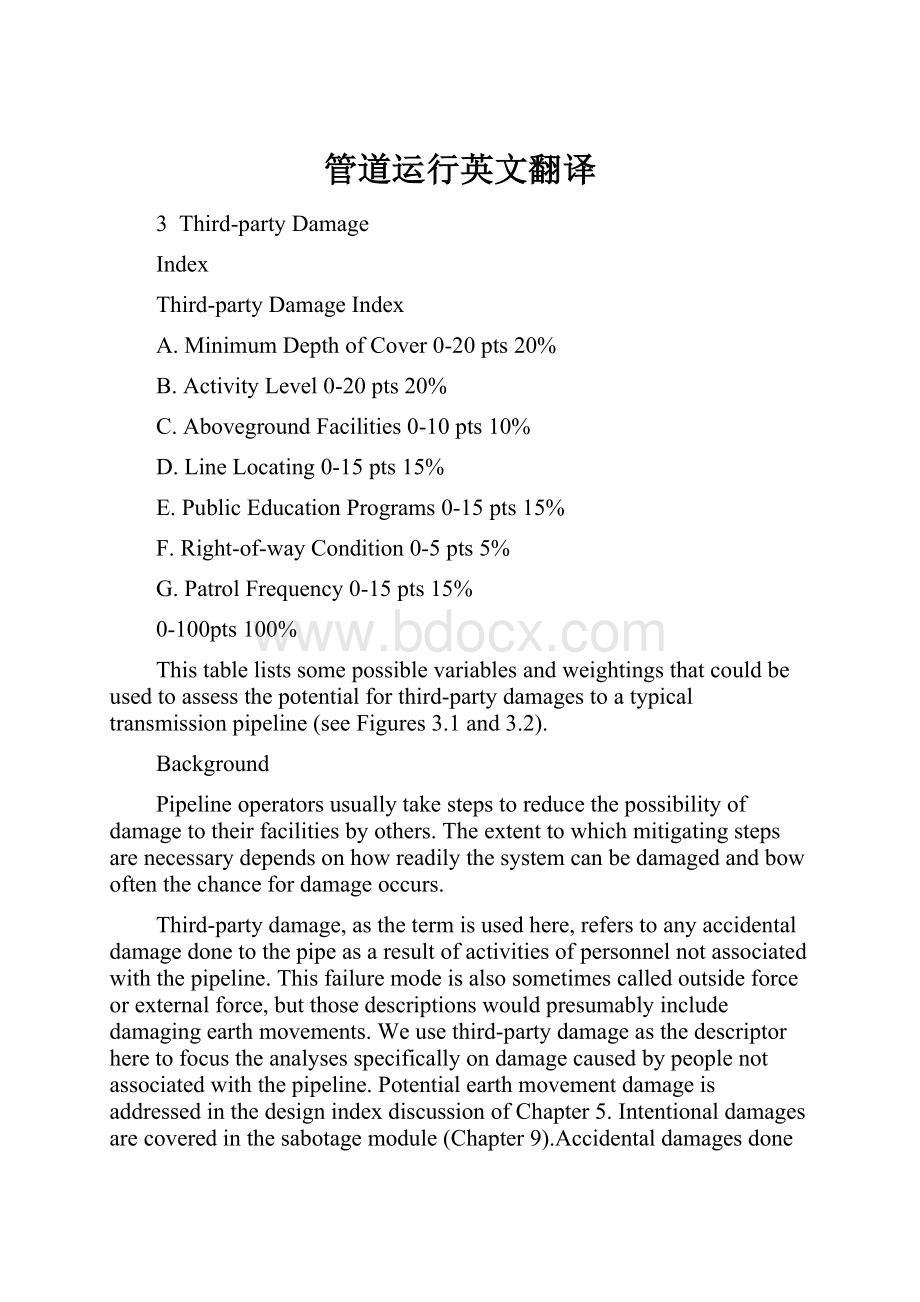管道运行英文翻译.docx
《管道运行英文翻译.docx》由会员分享,可在线阅读,更多相关《管道运行英文翻译.docx(28页珍藏版)》请在冰豆网上搜索。

管道运行英文翻译
3Third-partyDamage
Index
Third-partyDamageIndex
A.MinimumDepthofCover0-20pts20%
B.ActivityLevel0-20pts20%
C.AbovegroundFacilities0-10pts10%
D.LineLocating0-15pts15%
E.PublicEducationPrograms0-15pts15%
F.Right-of-wayCondition0-5pts5%
G.PatrolFrequency0-15pts15%
0-100pts100%
Thistablelistssomepossiblevariablesandweightingsthatcouldbeusedtoassessthepotentialforthird-partydamagestoatypicaltransmissionpipeline(seeFigures3.1and3.2).
Background
Pipelineoperatorsusuallytakestepstoreducethepossibilityofdamagetotheirfacilitiesbyothers.Theextenttowhichmitigatingstepsarenecessarydependsonhowreadilythesystemcanbedamagedandbowoftenthechancefordamageoccurs.
Third-partydamage,asthetermisusedhere,referstoanyaccidentaldamagedonetothepipeasaresultofactivitiesofpersonnelnotassociatedwiththepipeline.Thisfailuremodeisalsosometimescalledoutsideforceorexternalforce,butthosedescriptionswouldpresumablyincludedamagingearthmovements.Weusethird-partydamageasthedescriptorheretofocustheanalysesspecificallyondamagecausedbypeoplenotassociatedwiththepipeline.PotentialearthmovementdamageisaddressedinthedesignindexdiscussionofChapter5.Intentionaldamagesarecoveredinthesabotagemodule(Chapter9).Accidentaldamagesdonebypipelinepersonnelandcontractorsarecoveredintheincorrectoperationsindexchapter(Chapter6).
U.S.DepartmentofTransportation(DOT)pipelineaccidentstatisticsindicatethatthird-partyintrusionsareoftentheleadingcauseofpipelinefailure.Some20to40percentofallpipelinefailuresinmosttimeperiodsareattributedtothird-partydamages.Inspiteofthesestatistics,thepotentialforthird-partydamageisoftenoneoftheleastconsideredaspectsofpipelinehazardassessment.
Thegoodsafetyrecordofpipelineshasbeenattributedinparttotheirinitialinstallationinsparselypopulatedareasandtheirburial2.5to3feetdeep.However,encroachmentsofpopulationandlanddevelopmentactivitiesareroutinelythreateningmanypipelinestoday.
Intheperiodfrom1983through1987,eightdeaths,25injuries,andmorethan$14millioninpropertydamageoccurredinthehazardousliquidpipelineindustryduesolelytoexcavationdamagebyothers.Thesetypesofpipelinefailuresrepresent259accidentsoutofatotalof969accidentsfromallcauses.Thismeansthat26.7%ofallhazardousliquidpipelineaccidentswerecausedbyexcavationdamage[87].
Inthegaspipelineindustry,asimilarstoryemerges:
430incidentsfromexcavationdamagewerereportedinthe1984-1987period.Theseaccidentsresultedin26deaths,148injuries,andmorethan$18millioninpropertydamage.Excavationdamageisthoughttoberesponsiblefor10.5%ofincidentsreportedfordistributionsystems,22.7%ofincidentsreportedfortransmission/gatheringpipelines,and14.6%ofallincidentsingaspipelines[87].Europeangaspipelineexperience,basedonalmost1.2millionmile-yearsofoperationsinnineWesternEuropeancountries,showsthatthird-partyinterferencerepresentsapproximately50%ofallpipelinefailures[44].
Figure3.1Basicriskassessmentmodel.
Figure3.2Assessingthird-partydamagepotential:
sampleofdatausedtoscorethethird-partydamageindex.
Exposure
Toquantifytheriskexposurefromexcavationdamage,anestimateofthetotalnumberofexcavationsthatpresentachancefordamagecanbemade.Reference[64]discussestheGasResearchInstitute’s(GRI’s)1995studythatmakesanefforttodetermineriskexposureforthegasindustry.Thestudysurveyed65localdistributioncompaniesand35transmissioncompaniesregardinglinehits.Theaccuracyoftheanalysiswaslimitedbytheresponse-lessthanhalf(41%)ofthecompaniesresponded,andseveralmajorgas-producingstateswerepoorlyrepresented(onlyonerespondentfromTexasandonefromOklahoma).TheGRIestimatewasdeterminedbyextrapolationandmaybesubjecttoalargedegreeoferrorbecausethedatasamplewasnotrepresentative.
Basedonsurveyresponses,however,GFUcalculatedanapproximatemagnitudeofexposure.Forthosecompaniesthatresponded,atotalof25,123hitstogaslineswererecordedin1993;fromthat,theGRIestimatedtotalU.S.pipelinehitsin1993tobe104,128.Forarateofexposure,thisnumbercanbecomparedtopipelinemiles:
For1993,usingareported1,778,600milesofgastransmission,main,andservicelines,thecalculatedexposureratewas58hitsper1000linemiles.Transmissionlineshadasubstantiallylowerexperience;arateof5.5hitsper1000miles,withdistributionlinessuffering71hitsper1000miles[64].Allratesarebasedonlimiteddata.
Becausetheriskofexcavationdamageisassociatedwithdiggingactivityratherthansystemsize,“hitsperdigs”isausefulmeasureofriskexposure.ForthesameyearthatGRIconducteditssurvey,one-callsystemscollectivelyreceivedmorethananestimated20millioncallsfromexcavators.(Thesecallsgenerated300millionwork-sitenotificationsforparticipatingmemberstomarkmanydifferenttypesofundergroundsystems.)UsingGRI’sestimateofhits,theriskexposureratefor1993was5hitsper1000notificationstodig[64].
Riskvariables
ManymitigationmeasuresareinplaceinmostWesterncountriestoreducethethreatofthird-partydamagestopipelines.Nonetheless,recentexperienceinmostcountriesshowsthatthisremainsamajorthreat,despiteoftenmandatorysystemssuchasone-callsystems.Reasonsforcontinuedthird-partydamage,especiallyinurbanareas,include
●Smallercontractorsignorantofpermitornotificationprocess
●Noincentiveforexcavatorstoavoiddamagingthelineswhenrepaircost(todamagingparty)issmallerthanavoidancecost.
●Inaccuratemaps/records
●Impreciselocationsbyoperator.
Manyofthesesituationsareevaluatedasvariablesinthesuggestedriskassessmentmodel.
Thepipelinedesigneran4perhapstoanevengreaterextent,theoperatorcanaffecttheprobabilityofdamagefromthird-partyactivities.Asanelementofthetotalriskpicture,theprobabilityofaccidentalthird-partydamagetoafacilitydependson.
●Theeasewithwhichthefacilitycanbereachedbyathirdparty
●Thefrequencyandtypeofthird-partyactivitiesnearby.
Possibleoffendersinclude
●Excavatingequipment
●Projectiles
●Vehiculartraffic
●Trains
●Farmingequipment
●Seismiccharges
●Fenceposts
●Telephoneposts
●Wildlife(cattle,elephants,birds,etc.)
●Anchors
●Dredges.
Factorsthataffectthesusceptibilityofthefacilityinclude
●Depthofcover
●Natureofcover(earth,rock,concrete,paving,etc.)
●Man-madebarriers(fences,barricades,levees,ditches.etc.)
●Naturalbarriers(trees,rivers,ditches,rocks,etc.)
●Presenceofpipelinemarkers
●Conditionofrightofway(ROW)
●Frequencyandthoroughnessofpatrolling
●Responsetimetoreportedthreats.
Theactivitylevelisoftenjudgedbyitemssuchas:
●Populationdensity
●Constructionactivitiesnearby
●Proximityandvolumeofrailorvehiculartraffic
●Offshoreanchoringareas
●Volumeofone-callsystemreports
●Numberofotherburiedutilitiesinthearea.
Seriousdamagetoapipelineisnotlimitedtoactualpuncturesoftheline.Amerescratchonacoatedsteelpipelinedamagesthecorrosion-resistantcoating.Suchdamagecanleadtoacceleratedcorrosionandultimatelyacorrosionfailureperhapsyearsinthefuture.Ifthescratchisdeepenoughtohaveremovedenoughmetal,astressconcentrationarea(seeChapter5)couldbeformed,whichagain,perhapsyearslater,mayleadtoafailurefromfatigue,eitheraloneorincombinationwithsomeformofcorrosion-acceleratedcracking.
Thisisonereasonwhypubliceducationplayssuchanimportantroleindamageprevention.Tothecasualobserver,aminordentorscratchinasteelpipelinemayappearinsignificant-certainlynotworthyofmention.Apipelineoperatorknowsthepotentialimpactofanydisturbancetotheline.Communicatingthistothegeneralpublicincreasespipelinesafety.
Severalvariablesarethoughttoplayacriticalroleinthethreatofthird-partydamages.Measuringthesevariablescanthereforeprovideanassessmentoftheoverallthreat.Notethatintheapproachdescribedhere,thisindexmeasuresthepotentialforthird-partydamage-notthepotentialforpipelinefailurefromthird-partydamages.Thisisasubtlebutimportantdistinction.Iftheevaluatorwishestomeasurethelatterinasingleassessment,additionalvariablessuchaspipestrength,operatingstresslevel,andcharacteristicsofthepotentialthird-partyintrusions(suchasequipmenttypeandstrength)wouldneedtobeaddedtotheassessment.
Assessingthird-partydamagepotential
A.Minimumdepthofcover(weighting:
20%)
Theminimumdepthofcoveristheamountofearth,orequivalentcover,overthepipelinethatservestoprotectthepipefromthird-partyactivities.
Ascheduleorsimpleformulacanbedevelopedtoassignpointvaluesbasedondepthofcover.Inthisformula,increasingpointsindicateasafercondition;thisconventionisusedthroughoutthisbook.Asampleformulafordepthofcoverisasfollows:
Amountofcoverininches-3=pointvalueuptoamaximumof20points
Forinstance,
42in.ofcover=42+3points=14points
24in.ofcover=24+3points=8points
Pointsshouldbeassessedbasedontheshallowestlocationwithinthesectionbeingevaluated.Theevaluatorshouldfeelconfidentthatthedepthofcoverdataarecurrentandaccurate;otherwise,thepointassessmentsshouldreflecttheuncerta